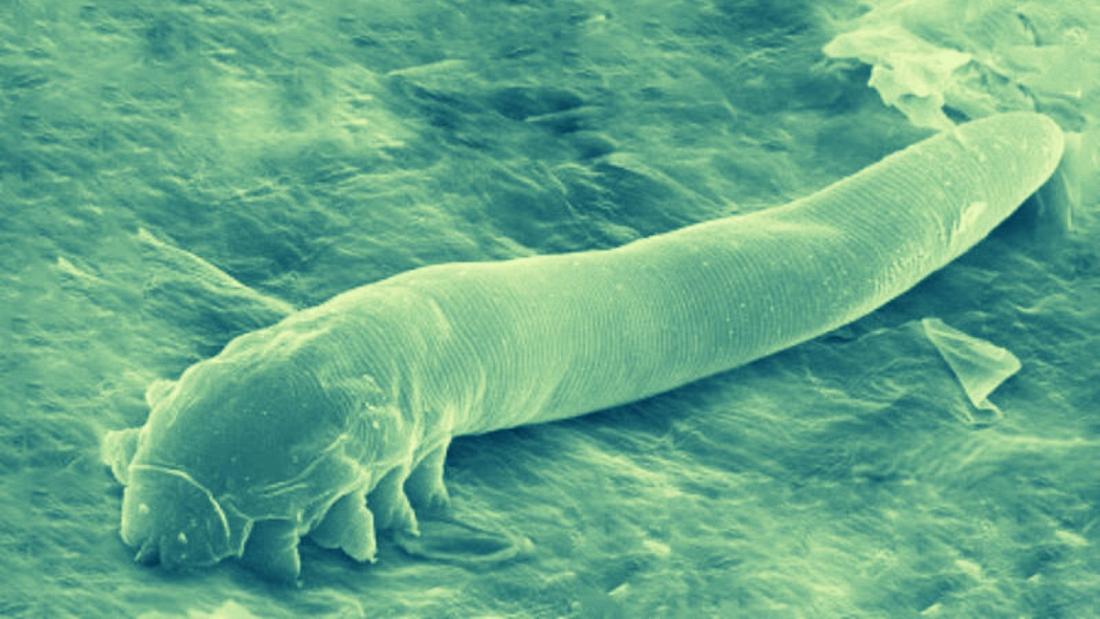Parasite skin mites that eat and mate on our faces while we sleep are evolving to be part of us
Around 90 per cent of humans have these mites living on them
Around 90 per cent of humans have these mites living on them – Copyright Creative Commons/Palopoli et al
By Luke Hurst • Updated: 22/06/2022 – 12:02
Tiny mites that live on almost all humans and mate on our skin may be evolving from parasites to creatures that share a symbiotic existence with us.
That’s according to scientists researching the creatures, which are a fraction of a millimetre in length, and are found in the hair follicles on the face and nipples.
The mites, called Demodex folliculorum, feed on sebum, a substance that coats the skin which is naturally released by cells inside our pores.
This breakthrough drug trial saw cancer vanish in every patient
At night, they leave their hiding place to mate on our faces while we sleep.
Around 90 per cent of humans have these mites living on them, and they are passed on at birth. They’re usually harmless and go unnoticed, but in large numbers they can irritate the skin, make it flaky and cause redness and itchiness.
They are one of two types of follicular mite species living on humans, alongside Demodex brevis, which is a solitary species inhabiting the sebaceous glands under the skin.
From parasitic, to symbiotic
Until now, they had been thought to have a parasitic relationship with us, extracting nutrients at our expense.
However, the new research suggests they may be becoming symbiotic, meaning their existence grants a mutually beneficial relationship.
For instance, it was previously thought the mites did not have an anus and would therefore accumulate their faeces for their whole lives before releasing it upon death and causing skin inflammation.
This is however not the case, according to the research conducted by scientists at the University of Reading, the University of Valencia, University of Vienna and National University of San Juan.
Exercise pill: Scientists identify molecule that could help drugs replace workouts
The new study, published in the journal Molecular Biology and Evolution, found the mites do in fact have an anus, and have been unfairly blamed for many skin conditions.
They may even help to keep our skin clean.
“Mites have been blamed for a lot of things. The long association with humans might suggest that they also could have simple but important beneficial roles, for example, in keeping the pores in our face unplugged,” said Dr Henk Braig, co-lead author from Bangor University and the National University of San Juan.
‘Unusual body features’
In the first ever genome sequencing study of the mites, it was found their isolated existence and inbreeding is causing them to lose unnecessary genes and cells and to become more simple organisms that may soon be at one with their human host.
“We found these mites have a different arrangement of body part genes to other similar species due to them adapting to a sheltered life inside pores,” said Dr Alejandra Perotti, Associate Professor in Invertebrate Biology at the University of Reading, who co-led the research.
“These changes to their DNA have resulted in some unusual body features and behaviours”.
These include the development of tiny legs made up of just three single cell muscles.
Justin Bieber’s facial paralysis: What is Ramsay Hunt syndrome and is it linked to COVID vaccines?
The loss of genes also means they lack UV protection, have lost the gene that causes animals to wake up with daylight, and cannot produce melatonin on their own.
Instead, they fuel up on melatonin from human skin, as they gear up for what the researchers call “all-night mating sessions”.
The paper goes into detail about the mating habits and sexual anatomy of the mites.
Notably, the males have a penis that protrudes upwards from the front of their body, and they have to position themselves under females during mating, which takes place as they both cling to human hair.
We may not be living with the mites forever though. The research has found the lack of exposure to potential mates that could add new genes to the offspring means they may be on course for extinction.

























